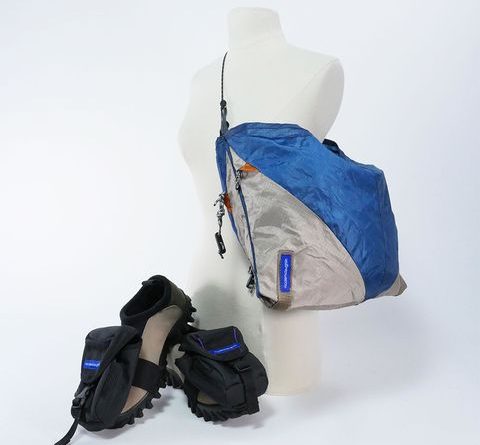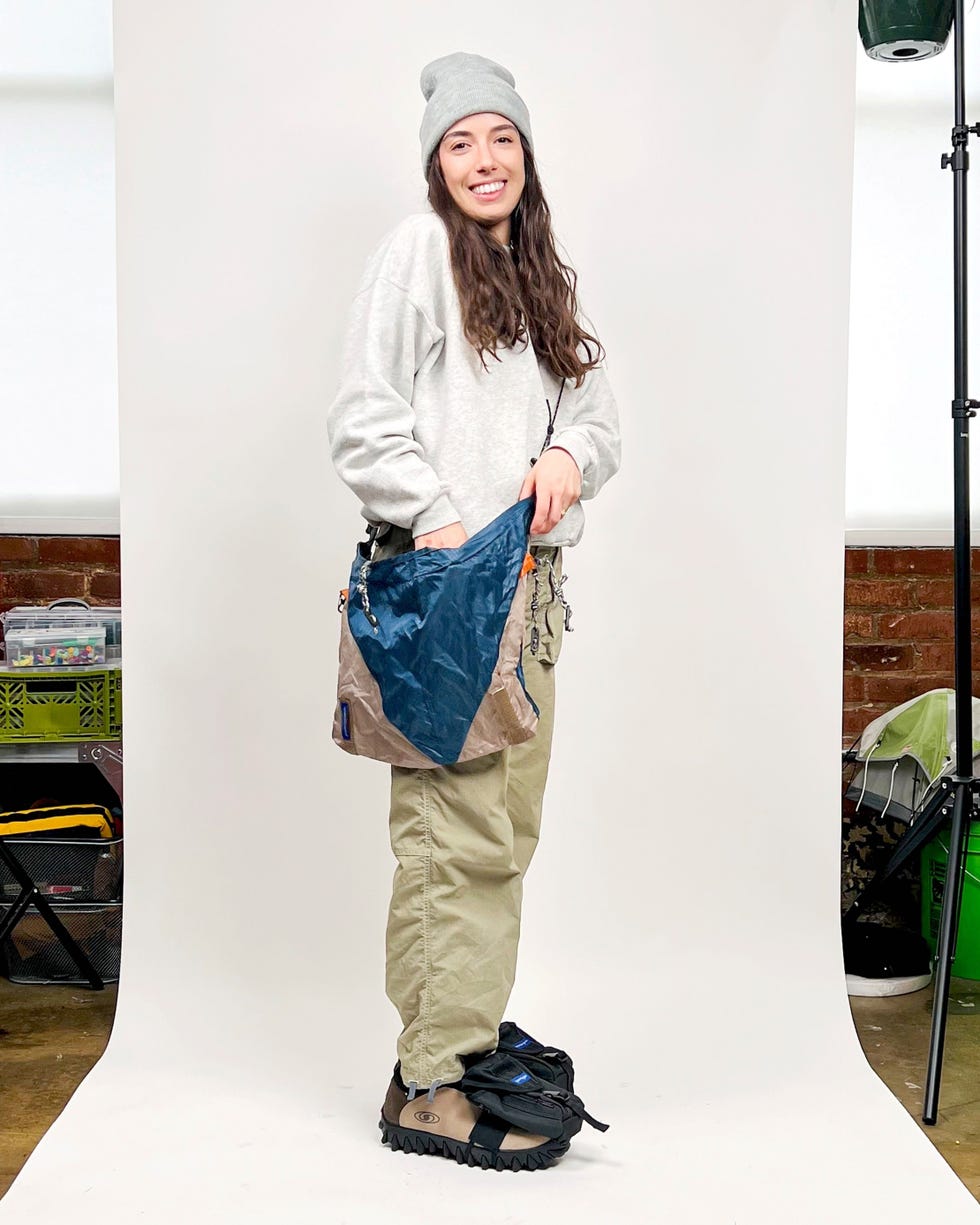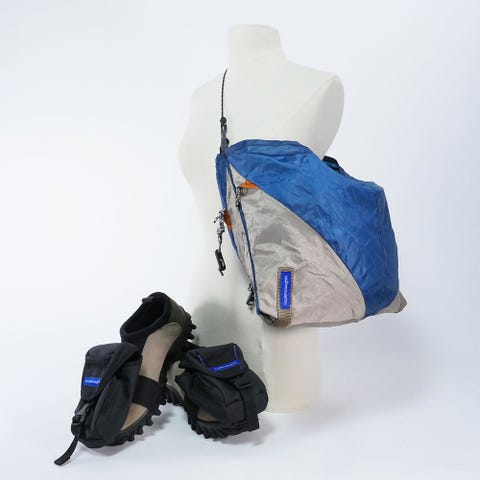Nicole McLaughlin Wants to Clean Out Your Junk Drawer
Have you ever bought a baguette and thought, “this would make the perfect beanie”? Nicole McLaughlin certainly has. The Brooklyn-based artist and designer began her career by taking items across all disciplines, regardless of wearability, and turning them into covetable fashion items. Think: Puma gloves sewn into a motocross jacket, a croissant bra (a “brassant,” as she calls it), Carhartt beanies as shorts. The basis of all her work stems from sustainability and upcycling practices, taking what already exists and morphing it into something practical, ecological, and whimsical in one fell swoop. In honor of Earth Month, McLaughlin has partnered with eBay to create four new specialty pieces that will be auctioned off every Monday in April, starting with the reworked Salomon shoes below.
One of the original purveyors of upcycling—long before it was a buzzword in the fashion industry—eBay is a pioneer of the online marketplace. It makes sense, then, that this partnership came about seamlessly, as both parties are actively committed to helping the planet. Case in point: From 2016 to 2020, eBay shoppers’ purchases in the electronics and fashion categories reduced carbon emissions by approximately 3.1 million tons. Furthermore, eBay has set a new commitment to create $20 billion in positive economic impact and avoid 8 million metric tons of carbon emissions through users selling their pre-loved items online. All of the proceeds from McLaughlin’s auction will be donated to Or Foundation, an organization based in both the U.S. and Ghana actively working toward environmental justice in the fashion education and development sectors.
Below, ELLE.com spoke exclusively with McLaughlin about the new partnership, the future of upcycling and sustainability, and what’s on her eBay Watchlist.
What does your design process look like? Do you start by finding an object, then figure out how you’re going to turn it into a wearable piece? Or is it the other way around?
That’s a good question, because it kind of goes both ways. It really does depend. Sometimes, I’ll daydream about a project and start to figure out, “Oh, what if I did a jacket out of this material?” and then it becomes the hunt to go and find the material that I’m looking for. But a lot of the time, I do find myself looking for inspiration, and for me, that’s looking secondhand. I think the easiest way is going on my phone and looking through secondhand pieces. That’s why this partnership [with eBay] made so much sense, because a lot of the time when I’m trying to come up with an idea for a project, I will scroll on eBay. I’ll look up a random word, or a year, or a brand that I’m interested in, and look through and see what comes up. That sometimes will dictate the project and the piece itself.
It seems like more and more people are starting to shop secondhand, even though eBay has been around for so long. Since all of your pieces are derived from ready-made objects, clearly sustainability is important to you. How much does that factor into what materials you decide to work with?
I think that the sustainability aspect of my work is the driving factor of the pieces that I make, and the reason why I continue to do the things that I do. It comes back to the possibilities around secondhand materials. When I started upcycling, it was more for me to be able to teach myself how to sew and how to make pieces. I didn’t want to buy new materials because I didn’t know what I was doing, so I started to use secondhand materials, and I realized my love for them. There’s so much potential with every piece, and to be able to maximize a garment or an object in the most capacity that you can, using every single aspect of the material, has been the goal. For sustainability purposes, it’s been really exciting to see what the future looks like within upcycling, and hopefully seeing it more in the fashion industry in general. I would definitely say that sustainability has been the through line of my work.
This content is imported from Instagram. You may be able to find the same content in another format, or you may be able to find more information, at their web site.
There’s something to be said about working with something that already exists and finding ways to make it new and fresh. Is there a certain material or object that you haven’t already worked with that you want to create with next?
I’m starting to get more into the world of furniture and objects. I’ve been mostly in a footwear and fashion space, and I find that it’s a lot easier for me to use materials that are a bit more malleable. Something like nylon, fabrics that you can mold and shape, and it contours to your body, or foot, or whatever you’re trying to turn it into. Now I have this itch to explore harder materials, like wood or more difficult plastics, because there’s just so much of it. So I’m trying to get the skill set to be able to work with those things.
I mean—I learned how to sew doing all this. And so, I’m back in that mindset again, back to the learning phase of, “Okay, what are the machines?” Like, “What are the tools that I need to learn in order to be able to work with metal frames or plastic?” “What’s the next thing?”
You’ve also made a lot of different branded items, like Carhartt beanies as shorts, and the Puma jacket. Is there a brand you’re dying to work with?
Well, I love the outdoors—I’m very much inspired by nature. A lot of the work is to talk about protecting nature, but my hobbies also include rock climbing. So I’d say La Sportiva. They make my climbing shoes that I wear, but they also have a really amazing history of outdoor hiking and shoes as well. I collect some old vintage La Sportiva sneakers; I have a little bit of a collection.
Also, I want to work in the higher fashion space as well. I’ve done a little bit of work in that world, but it’s interesting to learn from them in terms of processes, and why things get discarded so easily because of quality standards. That doesn’t necessarily mean that the material itself is useless.
This content is imported from Instagram. You may be able to find the same content in another format, or you may be able to find more information, at their web site.
As far as sustainable brands who are doing something new and different, are there any that you’re particularly fond of?
Bode is a notable one because of where they sit within the industry—still considered higher fashion but has adopted into the street space. The fact that they use older textiles and really have full transparency with where they’re getting their materials, is cool. There’s also Gemsun. They use recycled straw to make their hats—they’ll take old straw pieces apart and use it. I also always look toward up-and-coming independent artists, like Zero Waste Daniel, who uses the smallest of small scraps of off-cuts. He’s been a cool person in that space, incorporating upcycling into a brand and also keeping things small and limited. Production is a big problem within the fashion industry. It’s still inherently unsustainable to be making so much, even if youvre using sustainable materials.
What’s on your eBay Watchlist right now?
Oh, my Watchlist always stays full. I’m maxed out on how many items I could watch on there, so I had to create burner eBay accounts. My Watchlist is more of a mood board to me, so it’s not always things that I need to have. I can see something and just appreciate the item itself and get inspired by it, and I don’t necessarily have to own it. But then, sometimes something will sit in my cart for a while and then I’m like, “Okay, I gotta have it now.” Recently, I’ve been looking at bike frames. Going back to the question you asked me earlier about working with materials that I haven’t experienced before, I’m looking into more metal, and bike frames specifically, to see if I can use them for chairs or furniture. Also, bike tires as well, seeing if I could find ways to use the rubber for a shoe or something.
My Watchlist is very odd. I have a couple of things that I look for when I’m searching on eBay. I’m always looking for lots, when people list multiples of things, or I’ll look for peoples’ junk drawer lots. People empty out drawers in their houses, and it they have all these weird little knickknacks. I don’t always buy them, but I like to get inspired by the different objects that people hold onto. There’s some type of sentimental value in things, and someone will list something on eBay because they don’t want to get rid of it. They don’t want to throw it away. They might not need it anymore, but they think someone else might need it.
It’s the ultimate worldwide garage sale. You can find Gucci handbags, but you can also shop for anything and everything you could possibly imagine.
Yeah, for sure. Also, with sneakers as well, the amount of history…all the authentic sneakers that are on there is cool to see. I love the idea of the archive of it all, and that you can go on eBay to see where these brands really started. Some of these people have kept these shoes for so many years, and have kept them in really good condition. It’s just incredible to go on and find something that’s a piece of history in a way.
Do you hope to see more brands, even in high fashion, enter the secondhand or upcycling space? What are your hopes?
I really hope to see more brands take responsibility for the things that they’ve made in the past and use it as a resource. These brands have taken time and money to develop all these materials and fabrics that have gone out into the market and sold, and then it all falls on the consumer to find a way to keep the life going. It should be the other way around, where these brands provide the materials and the garments for the consumer, but then, at some point, they take it back into their own hands and find a way to use it again.
For me, I think sustainability and upcycling are the future. I definitely see the beginning phases of it all. People do use the word “upcycling” now, whereas 30 years ago, we didn’t have this amount of stuff sitting on the planet, so it has to be the future. It comes down to, “What are the possibilities with the materials that we already have?” We don’t need to continuously create new things, because we have already what we need here. And also young, independent artists breaking through, because they’re the ones that are leading the conversation. A lot of these bigger brands should be taking some notes. I feel like this [partnership] is a really great opportunity to be able to showcase what the potential of upcycling could be. It all comes full circle: You can go on eBay to get inspired, and now you can sell pieces back for charity.
This content is created and maintained by a third party, and imported onto this page to help users provide their email addresses. You may be able to find more information about this and similar content at piano.io



